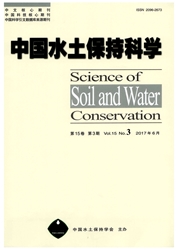

 中文摘要:
中文摘要:
CLIGEN是目前较全面产生降水要素(降水量、历时、达到最大降水强度的时间与降水总历时的比率、最大降水强度与平均降水强度的比率)的天气发生器,其生成降水要素的质量直接影响水文和农业响应模型的输出结果。利用黄土高原长武1957—2001年的日气象观测数据、王东沟流域1988--2001年的降水要素数据和CLIGEN生成的100年日气象数据,对CLIGEN模型产生日、月、年降水量的均值和方差、概率分布、降水极端值和降水历时、强度进行评估。结果表明:CLIGEN对日、月和年降水量均值的模拟效果较好,相对误差都不大于1.O%;对标准差的模拟结果偏低,相对误差的绝对值小于6.6%;没有模拟出日降水量的概率分布,但是较好地模拟出了月和年降水量的概率分布;对日、月和年最大降水量的模拟误差较大,表明CLIGEN对极值的模拟精度有待提高。CLIGEN很好地模拟出连续降水的频率,但是连续干旱天数在20d以内的累积频率的平均相对误差为8.9%;CLIGEN产生的最大降水强度与平均降水强度的比率高于实测数据;相对于实测数据,CLIGEN模拟的降水历时和降水量具有相同的趋势,对小降水量或短历时的模拟结果偏高,对大降水量或长历时的模拟结果偏低。
 英文摘要:
英文摘要:
Among the commonly used stochastic weather generator, CLIGEN is the only one that generates precipitation elements (i.e. precipitation amount, storm duration, time to peak, peak intensity), which will affect the output of hydrological and agricultural response models. Using daily weather data of Changwu weather station from 1957 to 2001, precipitation element data of Wandonggou watershed from 1988 to 2001 and 100 years of CLIGEN generated data, were the ability of the CLIGEN model to reproduce daily, monthly, and annual precipitation amounts, probability distribution, extremes, and internal storm patterns (i. e., storm duration and relative peak intensity) were evaluated. Means of daily, monthly, and annual precipitation were adequately preserved by CLIGEN and were evaluated absolute relative errors were not more than 1.0% ; Standard deviation were all unpredicted and the absolute relative errors were less than 6.6%. Two other probability distributions except daily precipitation were well simulated. Mean absolute relative errors for the all-time maxi- ma of daily, monthly, and yearly precipitation were relatively bigger than corresponding precipitation, suggesting that the ability of predicting extreme need to be improved. The frequencies of wet periods were relatively well replicated by the model, while the frequencies of dry periods less than 20 days have an average relative error of 8.9%. Relative peak intensity generated (ip) by CLIGEN was relatively overestimated than the measured. The CLIGEN-generated durations and precipitation have the similar trend, which were overpredicted for small storms or short duration and underpredicted for large storms or long duration compared with the measured.
 同期刊论文项目
同期刊论文项目
 同项目期刊论文
同项目期刊论文
 期刊信息
期刊信息
